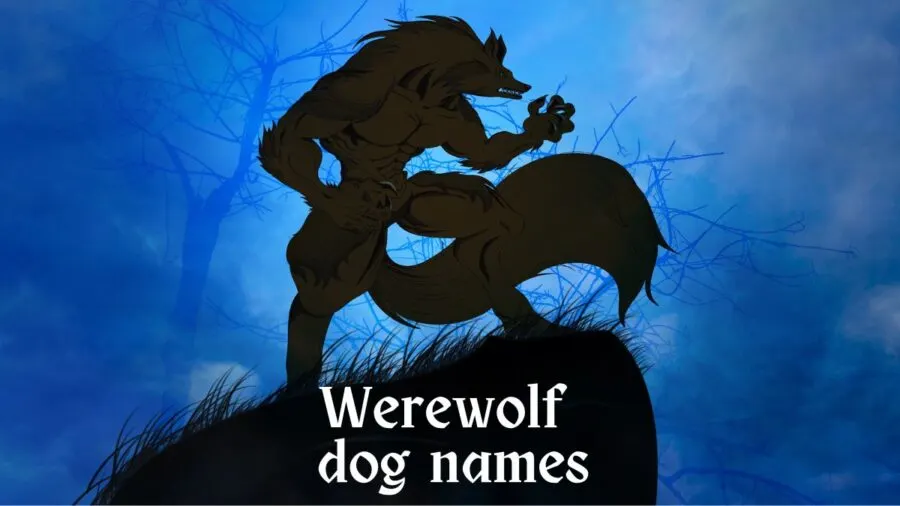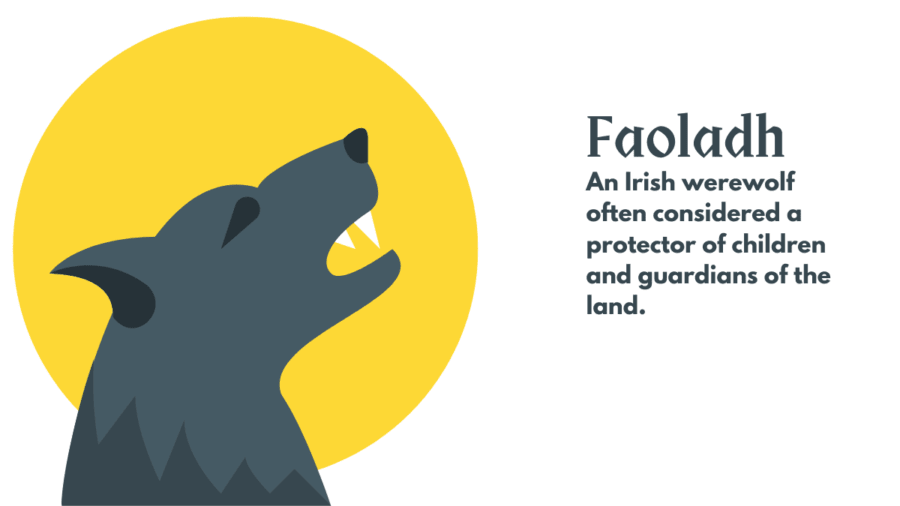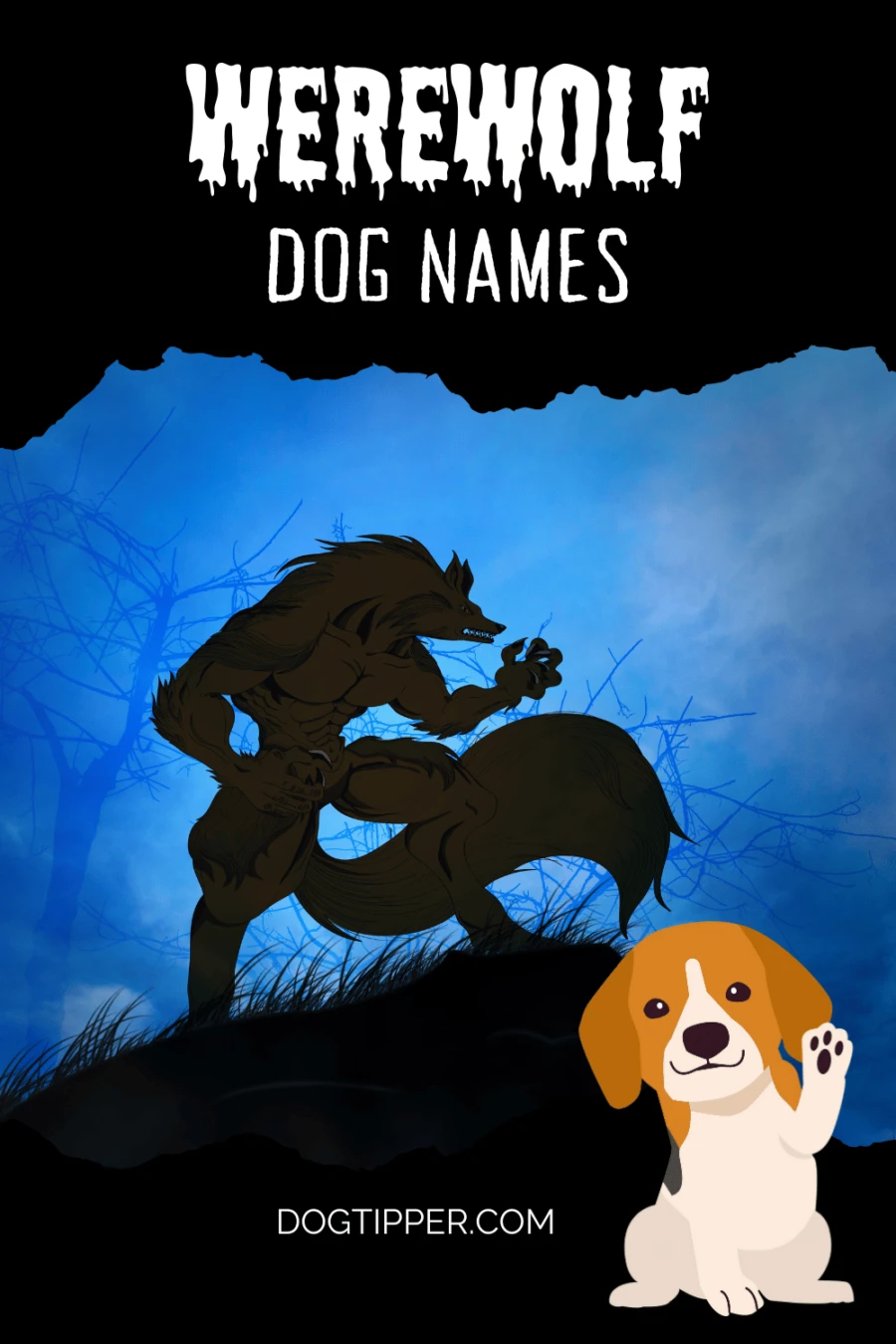Is your new puppy a howling, energetic bundle of fur that seems to embrace the moon’s glow? If your canine companion has a wild and spirited side reminiscent of the mythical werewolves, you might consider our collection of werewolf names for dogs. Whether you’re a fan of folklore, mythology or spooky shows, we’ve curated a list of captivating names inspired by werewolves to unleash the magic.

Why Select a Werewolf Name for Your Dog?
OK, we all know that genetically dogs are almost identical to wolves–and many dogs look like wolves–but what are the characteristics of the mythical werewolf?
- Transformation: The ability to change from human form into a wolf or a wolf-like creature, usually during a full moon. For a subtle nod to werewolves, consider the name Luna–always one of the most popular dog names.
- Enhanced Strength: Werewolves are often depicted as having increased physical strength, allowing them to overpower humans and other creatures.
- Enhanced Speed: They possess great speed, agility, and reflexes, which make them formidable adversaries.
- Heightened Senses: Werewolves typically have enhanced senses of sight, smell, and hearing, making them skilled hunters and trackers.
- Healing Factor: Werewolves may have accelerated healing abilities, allowing them to recover quickly from injuries.
- Immunity to Some Weapons: In certain folklore, werewolves are said to be immune to conventional weapons such as knives and guns, with only silver being able to harm or kill them.
- Insatiable Hunger: While in wolf form, werewolves may experience an uncontrollable and insatiable hunger for human flesh or blood.
- Pack Instincts: Like wolves, werewolves may exhibit strong pack instincts, forming social hierarchies and cooperating with other werewolves.
- Longevity: Some legends suggest that werewolves have extended lifespans, potentially living longer than normal humans. A fitting name for the senior dog you adopt.
- Night Vision: Werewolves may possess the ability to see clearly in the dark, aiding them in their nocturnal activities.
Mythological Werewolves
The concept of humans transforming into wolves or wolf-like creatures is a widespread and ancient belief found in numerous folktales, legends, and religious traditions.
Hungary
Farkasember: In Hungarian folklore, the werewolf is known as “Farkasember,” which literally translates to “wolf-man” or “wolf-person.”
Vérfarkas: A regional variation, “Vérfarkas” means “blood-wolf” in Hungarian. The Vérfarkas is believed to be a more malevolent and dangerous form of werewolf that craves human blood.
Latvia
Vilkacis: Vilkacis is a mythical creature from Latvian folklore. The term “Vilkacis” translates to “wolf eyes” in Latvian, and the creature is often described as a shape-shifter or a wolf-like being with human characteristics. Vilkacis is considered a type of werewolf in Latvian mythology.
In the folklore, a person could become a Vilkacis by engaging in certain rituals or making pacts with supernatural forces. The transformation into a Vilkacis was often believed to be voluntary, and individuals would gain the ability to transform into a wolf or wolf-like creature at will.
Similar to other werewolf legends, Vilkacis was thought to roam the forests and countryside at night, preying on livestock and occasionally on humans. In some versions of the folklore, Vilkacis was considered a protector of nature and forests and was not inherently evil.
France
Loup-garou: In French folklore, werewolves are often referred to as “loup-garou.” The term “loup-garou” is commonly used to describe a person who can transform into a wolf or a wolf-like creature, similar to the concept of werewolves in other cultures. The legend of the loup-garou is also found in French Canadian culture but the transformation is usually to a dog, not a wolf.
Romania
Vrkolak: In Romanian folklore, werewolves are commonly referred to as “strigoi” or “vrkolak.”
The concept of werewolves in Romanian mythology is closely tied to the broader category of “strigoi,” which encompasses various supernatural creatures, including vampires and shape-shifters.
Slavic Folklore
Volkodlak: Volkodlak is a term used to refer to a werewolf in Slavic folklore and some neighboring regions. The term is widely used in countries like Serbia, Croatia, Slovenia, and Bosnia and Herzegovina; it is essentially the Slavic equivalent of the English word “werewolf.”
In these cultures, the Volkodlak is often depicted as a shape-shifter, capable of transforming from a human into a wolf or a wolf-like creature. Like in other werewolf legends, the transformation is believed to occur during the full moon or as a result of a curse or other supernatural influences.
Ireland

Faoladh – Faoladh, also spelled as “Fénnid,” is a term used in Irish mythology to refer to werewolves or wolf warriors. In Irish folklore, Faoladh were believed to be individuals who could transform into wolves or had wolf-like attributes.
Unlike the typical werewolf legends in other parts of the world, Faoladh in Irish folklore were not necessarily seen as cursed or malevolent beings. Instead, they were often considered protectors of children and guardians of the land. According to some traditions, Faoladh would watch over and care for young children who were playing in the woods or near the wilderness, making sure they were safe from harm.
Scotland
Wulver: The Wulver is a creature from Shetland folklore. The Wulver is depicted as a wolf-like being with a human appearance from the waist up. Unlike traditional werewolves, the Wulver is generally considered to be a benevolent and solitary creature that is known for leaving fish on the doorsteps of the poor.
Japan
Kitsune (狐): In Japanese folklore, Kitsune are fox spirits with magical abilities, including shape-shifting–so you might consider them a werefox. While the primary form of a Kitsune is that of a fox, they are known to transform into human or other animal forms, including wolves. A fun name for a dog with fox-like features.
Caribbean Folklore
Loup Garou: In Caribbean folklore, there is a legendary creature known as the “Loup Garou” (also spelled “Loupgarou” or “Lugarou“). The Loup Garou is a werewolf-like figure found in the folklore of various Caribbean islands, including Haiti, and Trinidad and Tobago as well as some parts of Louisiana.
The Loup Garou is believed to be a shape-shifter, capable of transforming from a human into a monstrous creature, often resembling a large, black dog or a wolf. The transformation is said to occur during the night, particularly on certain significant dates, such as a full moon or specific religious holidays.
African Mythology
Bouda: In North African folklore, there are stories of “buda” or “bouda,” which are shape-shifters that can take the form of animals, including hyenas or wolves. Like the werehyenas, bouda are associated with witchcraft and dark magic.
Were-hyena: In parts of East Africa, particularly in Ethiopia and Sudan, there are legends of “werehyenas.” These creatures are believed to be shape-shifters that can transform between human and hyena forms. They are often associated with witchcraft and supernatural powers.
Louisiana Folklore
Rougarou: The Rougarou (also spelled “Rugaru” or “Rougaroo“) is a legendary creature from Cajun and Acadian folklore in Louisiana, USA. It is often described as a werewolf-like creature or a fearsome monster with various regional variations of the legend.
In the Cajun and Acadian traditions, the Rougarou is believed to be a shape-shifter, capable of transforming from a human into a wolf or a hybrid creature. The transformation is said to occur due to a curse or a punishment inflicted upon someone who has broken a cultural or societal taboo, such as not observing Lent or disobeying their parents. As a result, the person becomes a Rougarou, condemned to roam the swamps and forests of Louisiana during the night.
The Rougarou is often depicted as a creature of terror, preying on travelers and those who venture into the wilderness. Some tales describe it as having glowing red eyes, sharp teeth, and powerful claws. In certain versions of the legend, the curse can be passed on to others, making the fear of becoming a Rougarou a part of local cautionary folklore.
Greek and Roman Mythology
Ancient Greek and Roman mythology featured lycanthropy, the transformation of humans into wolves. The term “lycanthropy” itself is derived from the Greek word “lykos” (wolf) and “anthropos” (man).
Lycaon: In Greek mythology, Lycaon was the king of Arcadia and was said to have tested Zeus’ omniscience by serving him human flesh during a banquet. As punishment, Zeus transformed Lycaon into a wolf, making him the first werewolf. This myth is often cited as the origin of the term “lycanthropy.”
King Lycaeus: In Roman mythology, there is a similar figure to the Greek Lycaon known as King Lycaeus. According to the myth, King Lycaeus was an Arcadian king who was transformed into a wolf by Jupiter (the Roman equivalent of Zeus) as punishment for his wickedness.
Wulfhere: In Roman author Petronius’ work Satyricon, a story is told about a soldier named Wulfhere who undergoes a werewolf transformation during a full moon. This tale is one of the earliest surviving mentions of a werewolf in Roman literature.
European Werewolf Names
- Arnulf – “Eagle wolf” (Germanic origin)
- Bertrand – “Bright raven” (Germanic origin)
- Casimir – “Proclaiming peace” (Slavic origin)
- Diederik – “Ruler of the people” (Dutch origin)
- Edda – “Great grandmother” (Norse origin)
- Fenrir – “Fen-dweller” or “Monster wolf” (Norse origin)
- Garmr – “Raging wolf” (Norse origin)
- Harald – “Army ruler” (Scandinavian origin)
- Ingeborg – “Protection of Ing” (Norse origin)
- Jarl – “Nobleman” (Norse origin)
- Kaleb – “Faithful, dog-like” (Hebrew origin)
- Lycoris – “Wolf” (Greek origin)
- Mathilde – “Mighty in battle” (Germanic origin)
- Njal – “Champion” (Norse origin)
- Odulf – “Fortune wolf” (Dutch origin)
- Petronella – “Rock” or “Stone” (Greek origin)
- Ragnar – “Warrior” or “Judgment warrior” (Norse origin)
- Sigrun – “Victory rune” (Norse origin)
- Thora – “Thunder goddess” (Norse origin)
- Ulrik – “Noble ruler” (Scandinavian origin)
- Vidar – “Forest warrior” (Norse origin)
- Wulfric – “Wolf power” (Anglo-Saxon origin)
- Ylva – “She-wolf” (Norse origin)
- Zara – “Princess” or “Radiance” (Hebrew or Arabic origin)
Movie Werewolves
- Akasha – Queen of the Damned (2002)
- Embry Call – Twilight series
- Daniel “Oz” Osbourne – Buffy the Vampire Slayer (1997-2003)
- David – The Lost Boys (1987)
- David Kessler – An American Werewolf in London (1981)
- David Naughton – An American Werewolf in London (1981)
- Eddie Quist – The Howling (1981)
- Eleanor Braddock – The Beast Must Die (1974)
- Embry Call – Twilight series
- Fenrir Greyback – Harry Potter series
- Freddy Lee – Bad Moon (1996)
- Gabriel Martin – Wer (2013)
- Gary Brandner – The Howling (1981)
- George Sands – Being Human (UK TV Movie 2008)
- Ginger Fitzgerald – Ginger Snaps (2000)
- Jacob Black – Twilight movies
- Jackson Whittemore – Teen Wolf (1985)
- Jared Cameron – Twilight series
- Jordan Parrish – Teen Wolf (TV Series)
- Karen White – Howling II: Your Sister Is a Werewolf (1985)
- Karen White – The Howling (1981)
- Lawrence Talbot – The Wolf Man (1941)
- Lucian – Underworld (2003)
- Marsha Quist – The Howling (1981)
- Marie-Jeanne Valet – Curse of the Werewolf (1961)
- Michael Corvin – Underworld series
- Rafael – Howl (2015)
- Remus Lupin – Harry Potter and the Prisoner of Azkaban (2004)
- Sam Uley – Twilight series
- Selene – Underworld series
- Talan Gwynek – The Company of Wolves (1984)
- Theo Raeken – Teen Wolf (TV Series)
- Tyler Lockwood – The Vampire Diaries (TV Series)
- Valerie Sharpe – Red Riding Hood (2011)
- Will Randall – Wolf (1994)
- Zach Galligan – Waxwork (1988)
Werewolves in TV Shows
- Aiden – Being Human
- Alcide Herveaux – True Blood
- Brett Talbot – Teen Wolf
- Chris Argent – Teen Wolf
- Clayton Danvers – Bitten
- Corey Bryant – Teen Wolf
- Derek Hale – Teen Wolf
- Elena Michaels – Bitten
- Ethan Chandler – Penny Dreadful
- Hayley Marshall – The Originals
- Isaac Lahey – Teen Wolf
- Jackson Whittemore – Teen Wolf
- Jordan Parrish – Teen Wolf
- Josh Rosza – Being Human
- Kira Yukimura – Teen Wolf
- Liam Dunbar – Teen Wolf
- Logan Jonsen – Shadowhunters
- Malia Tate – Teen Wolf
- Mason Hewitt – Teen Wolf
- Peter Hale – Teen Wolf
- Rafael Waithe – Legacies
- Ray Sutton – Being Human
- Scott McCall – Teen Wolf
- Stefan Salvatore – The Vampire Diaries
- Talia Hale – Teen Wolf
- Theo Raeken – Teen Wolf
- Tyler Lockwood – The Vampire Diaries
- Vernon Boyd – Teen Wolf
More Dog Names You Might Like
Shark Names for Your Toothy Pup
180 Halloween Dog Names – A Monster List of Names for Your Fur Baby
Pin it to remember these werewolf names for dogs

- Sighthound Day - September 27, 2024
- Cottage Cheese Ice Cream for Dogs Recipe - July 29, 2024
- New Dog Treat Cookbooks! - June 17, 2024
